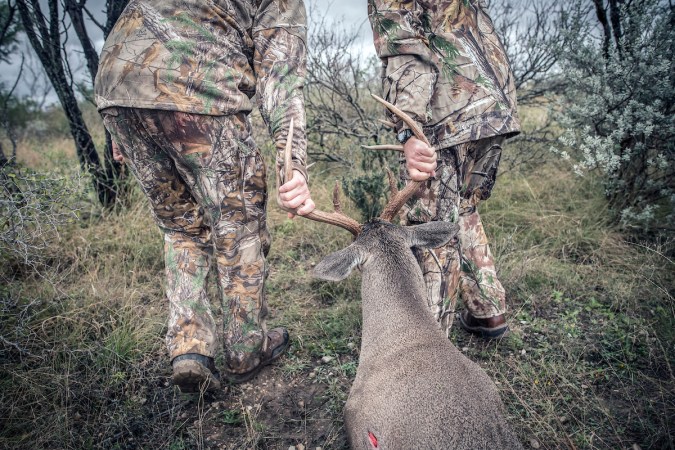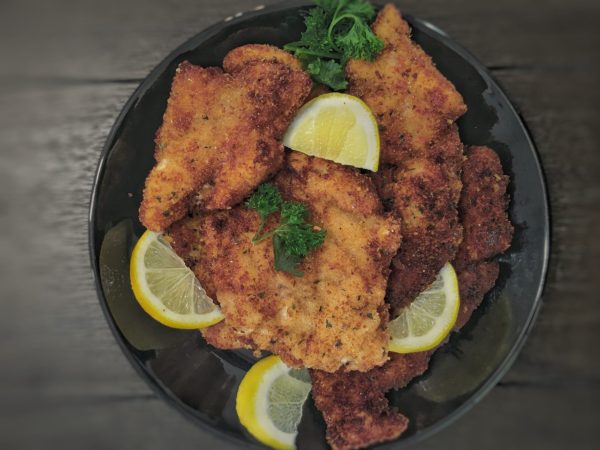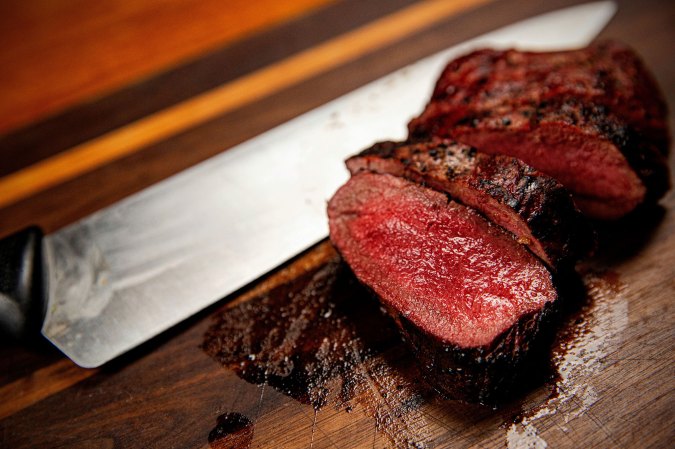If you’re ordering beef at a restaurant, you can expect the question: “How would you like that cooked?” Maybe you’re the type who wants a bloody steak. Maybe you prefer a burger that could have been a hockey puck in a former life. But when it comes to deciding on the perfect internal temp for venison, there are primarily two schools of thought. Cook venison to a lower internal temperature for superior taste and flavor, or cook it to a higher temperature to follow food safety guidelines.
- Government agencies recommend cooking venison to an internal temp of 160 degrees.
- Wild game chefs recommend cooking venison to an internal temp of 120 to 130 degrees.
There are a lot of differences between beef from a USDA-certified cow and venison from a whitetail with a tag taped around its leg. One main difference is that ranchers have more control over their livestock. Hunters lack that same control over wild-harvested venison. Most hunters can agree that we much prefer it this way. But that also means we have little control over—and awareness of—what that deer was exposed to during its lifecycle. That includes certain diseases and parasites. This is where cooking temperature comes into play. Unsurprisingly, food safety experts and chefs don’t exactly agree on what temperature is best.

How hot you choose to cook your venison will depend on how you prefer to balance the risk of getting sick from eating rarer meat with the pressing demands of your tastebuds. Some hunters take the “better safe than sorry” approach and cook their deer to well-done. For others, the choice is obvious: a perfect backstrap medallion beats the relatively small risk of getting sick.
To help you make that call, we researched state and federal guidelines. Then we asked some wild-game chefs to get an idea of what the perfect internal temp for venison is in the real world.
What Internal Temperature Should You Cook Venison To?
Government agencies all recommend the same internal temperature for cooking wild game from rabbit to venison. For safety reasons, officials say you should cook venison to a minimum internal temp of 160 degrees Fahrenheit, which is considered “well-done.”
What Venison Cooking Temperature Does the Government Recommend?
The U.S. Centers for Disease Control and Prevention plainly states: “Whole cuts and ground meat from wild game animals should be cooked to an internal temperature of 160°F.” But until a few years ago, the USDA said the same thing about beef. In 2020 the agency updated its guidelines for the safe minimum temperature of beef. They did so by reducing the recommendation from 160 degrees to 145 degrees, with three minutes of rest time after removing the meat from the heat source. (Those three minutes of rest time are supposed to get the internal temperature up to 160 degrees anyway, so the CDC’s end-goal for red meat hasn’t exactly changed.)
The U.S. Department of Health and Human Services gives guidelines for “rabbit and venison, wild or farm-raised” in their internal temperature cooking chart. That number sits squarely at 160 degrees with no rest period.
As you work down the HHS list, which is designed to significantly reduce the risk of foodborne illness (more on this later), you’ll discover a bleak world. Eggs over hard forever? No more sushi or ceviche? No more cold pepperoni pizza on a Saturday morning? Thanks, but no thanks. To be clear, we’re not advising you to eat your food undercooked. But if you’re willing to risk cold leftovers (seriously, the HHS advises that you heat all leftover food to a minimum temperature of 165 degrees), you might reconsider your stance on medium-rare venison.

The Best Internal Temp for Venison, According to Chefs and Hunters
These government guidelines for the minimum internal temp for venison begs the question: When is the last time you ate a well-done venison steak? Did you enjoy it? Wild game chefs recommend something very different when it comes to cooking deer meat.
For those who prefer a tender, rare-to-medium-rare muscle cut like a backstrap or tenderloin, wild game experts prefer an internal temperature of around 120 to 130 degrees for venison.
“I like 125 to 130,” says Michael Pendley, the author of Timber to Table recipes for RealTree. “It’s going to pick up a couple more degrees when you take it off the grill, out of the oven, or off the skillet. So I generally stop pretty rare on whole cuts. It’s safe past around 125” degrees.
Brooks Hansen is a lifelong hunter and the media relations and PR manager for Camp Chef, a company that specializes in cookware and knowledge-sharing for the meat-obsessed.
“If you’re doing a muscle meat, like a backstrap or a steak or a tenderloin, that thing needs to be cooked hot and fast,” Hansen says. “I pull it out around 120 to 125 degrees and then let it rest for about 10 to 15 minutes. I know that’s probably not the USDA recommendation, but medium-rare is 120 degrees on prime rib, so it’s 120 to 130 degrees on venison.”

If you’re trying to sell a non-hunting buddy on a bite of venison steak, it’s crucial to keep those muscle cuts tender and at least pink in the middle. According to Hansen, the public’s general aversion to the flavor of venison might be born from the tendency to overcook it.
“Venison got a bad rep for a long time because people said it tasted ‘muttony’ or ‘gamey,’ and it was kind of gray,” Hansen says. “But the main component of that was overcooked muscle meat. So there are certain cuts that are meant to go hot and fast. But people take these hot and fast cuts and overcook them because they were nervous about having any type of red or undercooked wild game.”
Does Cooking Venison Make It Safer to Eat?
The very reason we cook meat is to kill bacteria that might have emerged on the meat’s surface while it was exposed to air in temperatures above 40 degrees. So the short answer is yes, cooking the surface of a venison steak makes it safer to eat. But what does that mean for the internal temp of the venison? People seem to misunderstand is how safe the unexposed bites of a muscle cut really are.
“When you cook a whole muscle, there’s no contamination of any kind on the inside of that muscle,” explains Pendley. “When it sears on the outside, even cooked rare, the heat kills any contamination that might be on the outside of the muscle, making it safe.”

But Pendley also raises an important distinction. If you’re grinding venison, that changes the perfect internal temperature just slightly. (This practice is consistent with the HHS’ general approach to different types of meat, which recommends an internal temp of 145 degrees for beef cuts, but 160 degrees for ground meat of any kind.)
“When you grind the meat, of course you’re blending all that [surface area] up. You have what used to be the exterior of the meat now ground inside,” he says. “So on ground meat, I like to go a little warmer, up to 145 on my [venison] burger. I still won’t go well-done. I’m naturally against well-done venison. But 145 degrees kills just about everything that might be a problem.”
Government officials seem to think game meat is more dangerous than beef. But when it comes to burgers, Hansen feels more comfortable with less-cooked game burgers than beef burgers.
“I think you can be a lot more liberal with ground venison than with ground domestic beef. You really don’t know where it’s been. You don’t know the process, how long it was ground or exposed,” Hasnen explains. “With ground beef, you want to make sure it’s all the way to 160 [degrees]. But ground venison, I think you’re okay to go 10 degrees or more lower than that. I like a good medium to medium-rare burger. Especially if it’s meat you ground yourself and you know exactly what it’s been through.”
Keep Venison Cool Before Cooking
Refrigeration technology has come a long way since the days of root cellars and ice boxes. But with the power of keeping the ambient temperature in your refrigerator set exactly how you want it comes the responsibility of not letting raw meat sit out on a countertop—or out in the field—for hours on end.

There are some easy tips to follow to make sure you don’t spoil the meat before you even start breaking down the carcass, and risk foodborne illness later. Assuming you get everything cooled, butchered, and packaged in a clean and timely manner, the next place you must actively try to avoid contamination is in the kitchen.
As soon as the surface temperature of a piece of meat exceeds 40 degrees, bacteria starts to grow. In certain conditions, a bacterial colony can double in size in just 20 minutes. If you’re thawing or marinating venison, keep it in the refrigerator. In a pinch, you can defrost a package of venison in a bowl of water or even in the microwave, but make sure you’re cooking the meat as soon as possible. Otherwise, you brought it within the danger zone extra fast just to let bacteria form.
Does Cooking Venison Get Rid of Parasites?
This seems to be one of the more common concerns among diners who are less familiar with game meat preparation. They might have visions of microscopic worms wriggling through a cooked backstrap, alive and happy because the chef decided to serve the dish rare. But here’s the flaw in that logic: If meat is infected with something dangerous, it’s probably quite obvious.
“If there’s parasites, you’re going to see them long before you start cooking. As you butcher the animal and pull the steaks out, if there were a parasite or odd bacteria, you’ll see it,” Hansen says. “I came across a whole hindquarter that had white larvae in it. I wasn’t comfortable eating it, but the rest of that deer was more than edible. If there’s an off color to the meat, or an off-smell, those are some red flags to watch for. But for the most part, venison is so lean and smells so delicious.”
For the really parasite-wary, Pendley recommends getting the internal temp of your venison up to medium, since any parasites that might infest the meat (and sneak past the person butchering and preparing the meat) don’t really have a chance of surviving beyond that temperature. This is a good route to take if you’re concerned about toxoplasmosis, a microscopic parasite that can pass to humans through consumption of many different kinds of meat. (This is the same parasite that’s known to lurk in litter boxes.) Lots of people with toxoplasmosis don’t have symptoms, and an estimated 11 percent of the U.S. population over six years old carries it.
“Cooking venison to 145 degrees kills just about everything that might be a problem,” says Pendley. “With wild hogs and bear, you have the possibility of trichinosis. But with venison, you really don’t have those issues.”

As Pendley says, trichinosis is a parasite that tends to affect wild game that eats meat, like black bears and wild hogs. You can contract trichinosis by eating undercooked meat that contains the parasite, and that’s why both government agencies and wild game chefs recommend hunters follow the internal temperature guidelines for bear and wild hog meat. But deer are herbivores, and therefore not considered at risk of transmitting trichinosis to hunters. So you incur much less risk from parasites by cooking your venison to a lower temperature.
Can Cooking Venison Get Rid of CWD?
But what about other wildlife diseases? Parasites or no parasites, what if the animal is sick and we can’t tell? This is where the internal venison temperature debate tends to reach its conclusion. As far as we know, humans cannot currently contract CWD from deer and there has yet to be a recorded example of CWD jumping to humans. Therefore you probably won’t get sick from eating venison of a deer that was infected with CWD. Even so, you should not eat venison from a CWD-positive deer, advises the CDC. That’s because no amount of cooking can eliminate CWD in a piece of venison.
CWD is a prion disease that impacts the neurological tissues and nervous system of an infected animal. It’s not another bug or bacteria that a good sear can take care of. Prions can exist in soil for years and, as the Theodore Roosevelt Conservation Partnership puts it, “because they are not alive, CWD prions cannot be killed.”
That’s enough for some hunters to religiously test their animals and not eat meat from any that test positive. If you’re concerned about CWD and venison, your best bet is to test your deer after your hunt and before cooking any of the meat. (Hunters in certain CWD-positive areas are required to do this by law anyway.) If you get a positive test, don’t eat the meat. If you get a negative test, cook your venison steak however you want.
Can You Eat Venison Raw?
If the risk of parasites or bacteria don’t concern you, then you might be interested in trying raw or near-raw venison. Dishes like carpaccio (thin-sliced raw meat like beef or tuna) and tartare (seasoned and chopped raw meat) are considered delicacies, and properly processed venison can be relatively safe for preparing these dishes. If you’ve been the one handling your deer meat from field-dressing to the kitchen, then you’re the best judge to decide.
“I wouldn’t recommend it because I don’t want to get in trouble, and my wife and kids think I’m crazy,” Hansen says. “But yeah, every time I butcher a deer, after it’s hung and dry-aged, I’ll be cleaning it up and I’ll snack a little. I’ve done it for years, and I think the draw is that I want to see exactly what it tastes like” before I cook any of it.

If you aren’t quite ready to slice off a raw piece of backstrap and sample it, Pendley recommends a quick sear on the outside before preparing your raw venison dish.
“Say you want steak tartare. A good way to do that is to get a super hot skillet and sear the surface all over. That would kill any contaminants that might be on the surface, but still let you experience the cold center,” he says. “You could even just take a blow torch and sear the outside.”
Clearing Up the Venison Internal Temp Debate
Venison fans know that the best meat preparations usually don’t involve a 160-degree internal temperature, even though that’s what government agencies deem safe to eat. Unless the cut is spending a full day soaking in its own juices in a slow cooker or crackling in a smoker and breaking down to “pull-with-a-fork” status, it’s tough to ignore how delicious a pink-to-red center tastes. And even if your venison is ground, maybe you’re the type to take some liberties with internal temperature that you wouldn’t with a beef burger from the grocery store. Who is anyone to stop you?
But ultimately, you won’t enjoy a meal if you aren’t comfortable eating it. If a higher internal temp brings you more peace of mind, then leave your venison steak on the grill for another minute. Either way, wild game chefs say venison preparation should always complement the flavors of the meat, rather than try to cover them up. That’s why Pendley’s hands-down favorite preparation on a muscle cut is salt, pepper, and an extremely hot grill for just a few minutes. Hansen also wants the venison flavor to be front-and-center in the meat that he cooks.
Read Next: Venison Facts Amid the Lion Diet TikTok Craze and World Carnivore Month
“When people are like ‘Try this deer, you can’t even tell it’s deer, it doesn’t taste like deer,’ I’m like ‘Woah.’ That’s defeating the purpose,” Hansen says. “We shouldn’t need to wrap it in four strips of bacon and soak it in cream of mushroom soup to mask the delicious flavor of venison. If it’s cooked right, it’s amazing.”

















